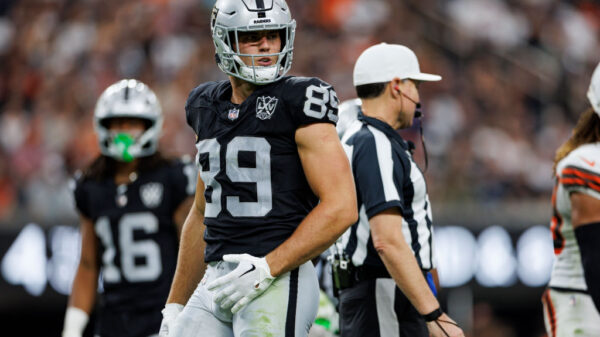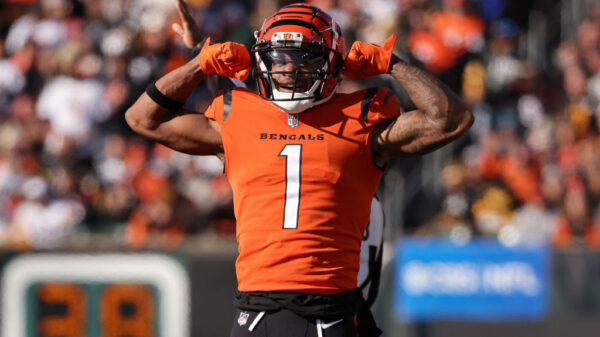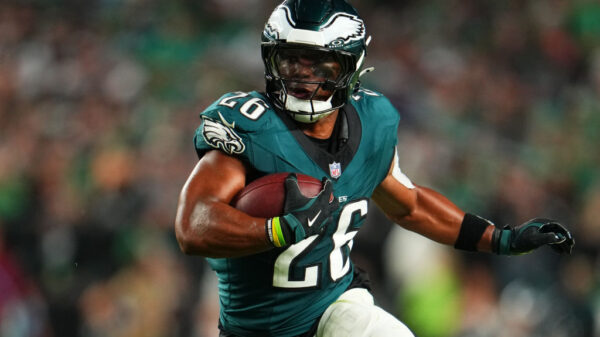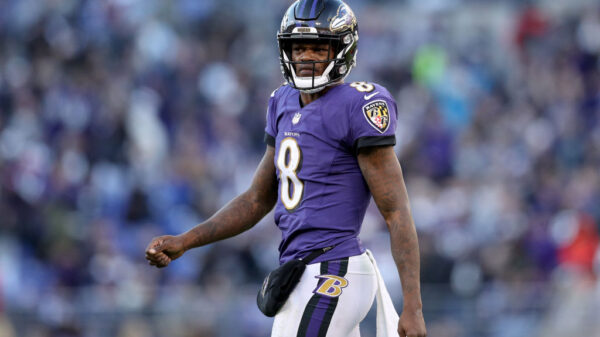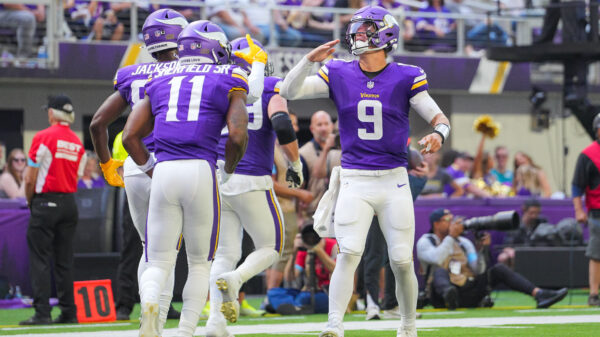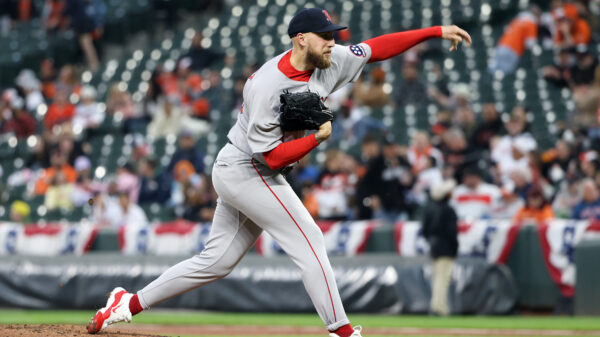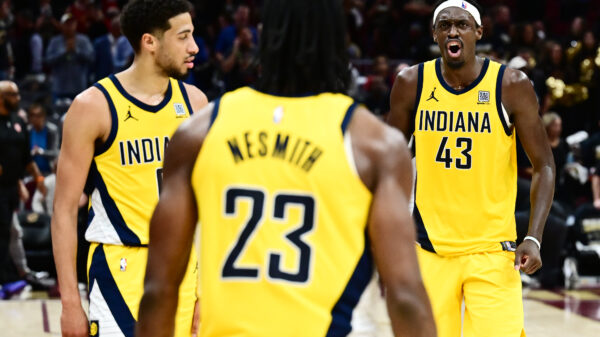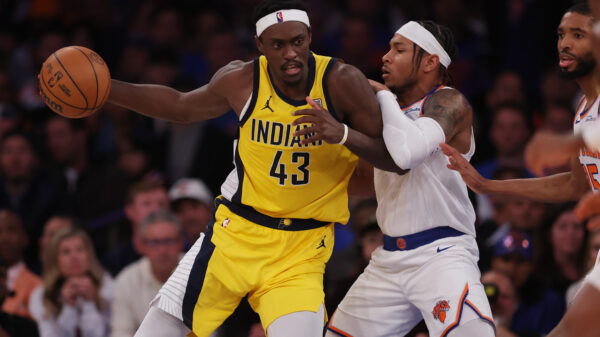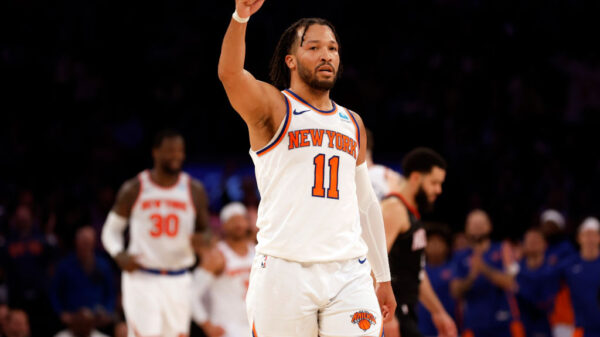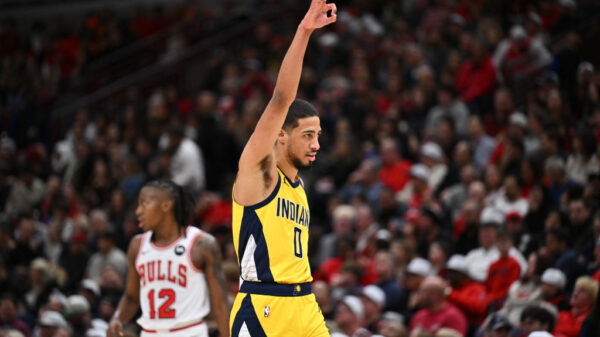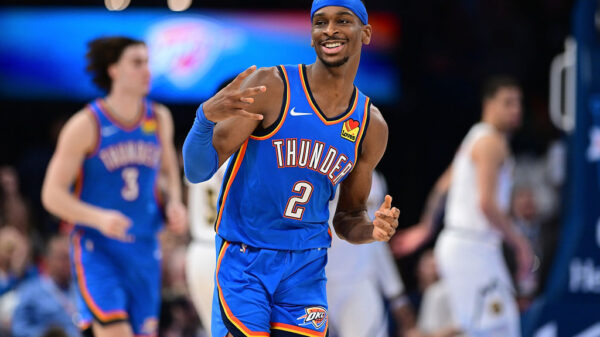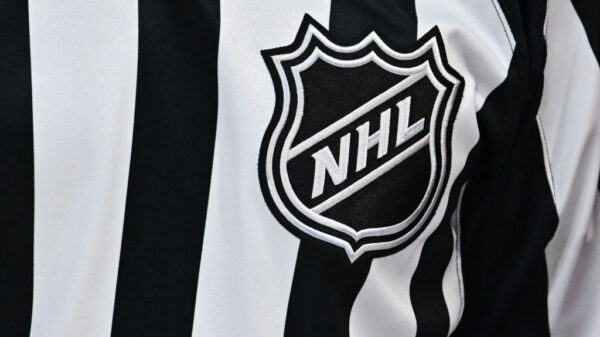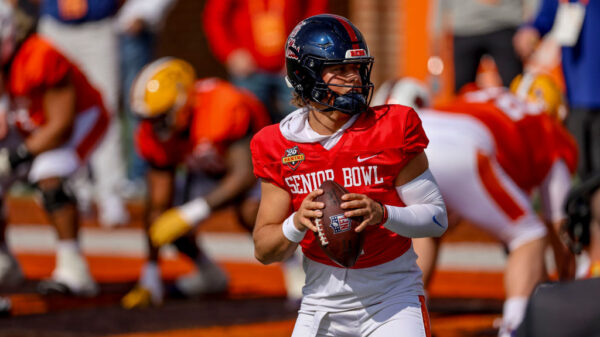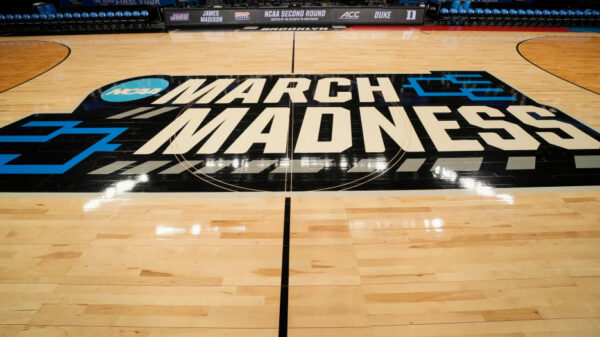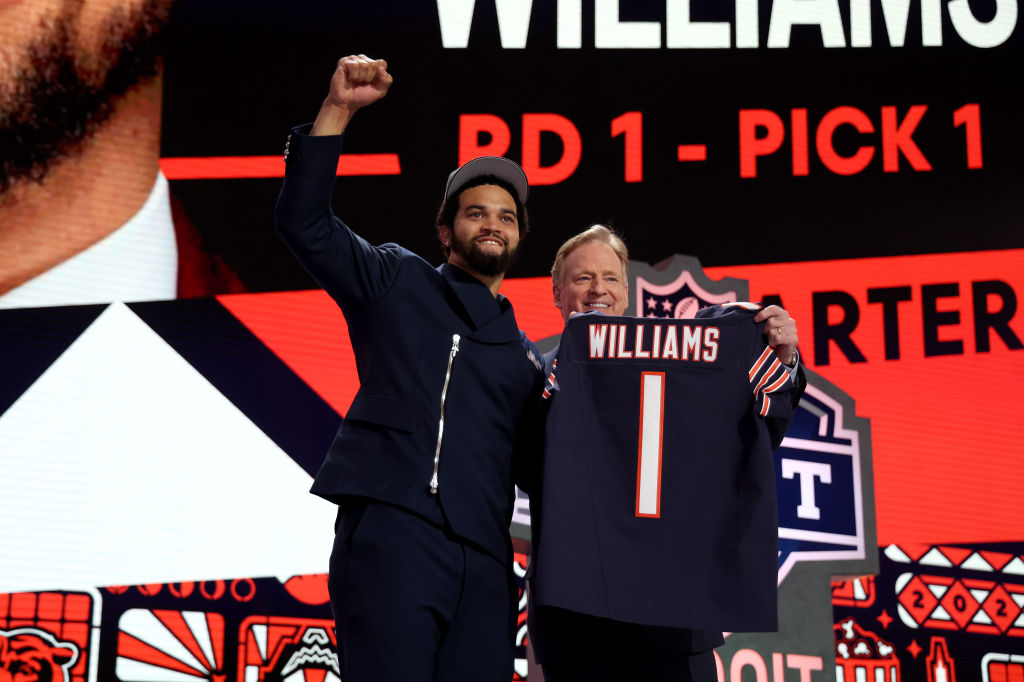The NFL Draft has come and gone, which means it is officially Dynasty Rookie Draft season! I was going to do a mock draft and analyze that, but I figured nothing compares to the real thing, so let’s take a look at the first two rounds of a recent home-league Rookie Draft I participated in. This league is a 10-team Superflex league, with Half-PPR scoring and very deep rosters (12-player starting lineups), but most of my takes here will apply to all Superflex formats. Without further ado, here are my opinions on how this draft shook out!
Disclaimer/Humblebrag: You don’t have to worry if I will be impartial about my own picks, as I traded away both my first and second-round picks long before draft day … and have the trophy to show for it.
Round 1
1.01: QB Caleb Williams, Chicago Bears
This pick is a no-brainer. Caleb Williams has a pristine prospect profile, literally perfect draft capital, and is heading to a suddenly stacked landing spot with three excellent receivers in Chicago. Given the extra value that quarterbacks have in Superflex leagues, I don’t think there is any reason to take anyone else here. Even if you feel set at the QB position, this is still the right move: Quarterbacks retain value, and you can never have too many.
1.02: WR Marvin Harrison Jr., Arizona Cardinals
This one is nearly as much of an obvious choice … but not quite. On the one hand, MHJ is one of the best prospects, at any position, we’ve seen in years. On the other hand, quarterback is King in Dynasty Superflex leagues. It’s the most scarce position, and it’s the position with the greatest longevity. I’m not going to say you should pass on MHJ at this pick if you feel very set at the QB position. But if you don’t, I would recommend picking the next guy …
1.03: QB Jayden Daniels, Washington Commanders
Don’t get me wrong, Daniels is riskier as a prospect than either Harrison or Williams. Some of his numbers under pressure are particularly concerning. But, as an elite dual-threat player, Daniels likely has some huge fantasy outings in his future. And Justin Fields just proved that a few huge fantasy weeks can push a quarterback’s value VERY high even if they aren’t playing winning NFL football. Even if he eventually busts, Daniels will likely provide a few sell windows for a savvy manager to take advantage of … and if he hits, he will be worth more than MHJ ever could be.
1.04-1.06: WR Malik Nabers, New York Giants + Rome Odunze, Chicago Bears + Drake Maye, New England Patriots
I’m grouping all three of these picks together because one of my leaguemates actually managed to acquire all three (he did tear his whole team down in the process, to be fair). To this tank commander’s credit, he made the right three choices with these picks. Nabers and Odunze are both truly elite receiver prospects whom I ranked in the second tier of my rookie WR rankings, and Maye has been criminally undervalued in most of my early rookie drafts. Maye’s situation really reminds me of C.J. Stroud last year: A consensus top QB pick who slides in rookie drafts due to prospect fatigue and a (perceived) bad landing spot. To be clear, I am NOT saying Maye is going to be Stroud, but I will happily take an elite QB prospect with top-three draft capital who is falling outside the top half of the first round in Superflex rookie drafts. I know I sound like a broken record, but QB is King, and Maye also has non-negligible rushing upside.
1.07: TE Brock Bowers, Las Vegas Raiders
Bowers is about as safe a pick as it gets. The hit rate on tight ends drafted in the first round, let alone the top half of the first round, recording a top-12 season is over 90%. Bowers, considered by many to be one of the top five most talented players in the draft, was selected 13th overall by the Raiders. Yes, the Raiders drafted Michael Mayer, another great TE prospect, in the second round last year, so this fit is a little weird. But Bowers is a truly generational prospect who put up elite receiving numbers for a receiver, let alone a tight end, in his time at Georgia. He will push for fantasy TE1 status from the moment he steps on the field and is a solid pick at this spot.
1.08: QB J.J. McCarthy, Minnesota Vikings
I think the eighth overall pick is about right for McCarthy. I’ve seen some experts suggesting he should go much higher, potentially even above Maye, and I just can’t get on board with that. Yes, the landing spot with the Vikings is excellent: Justin Jefferson, T.J. Hockenson, Jordan Addison, and, perhaps most importantly, Kevin O’Connell will make his life easier. But quarterback is a position where talent is more important than situation, and even the Vikings (who reportedly tried to trade up for the Patriots’ third overall pick) clearly didn’t view McCarthy as a prospect on the same tier as the top three QBs in this class. In my opinion, he and Bowers are a tier to themselves after the big three QBs and big three WRs, with who you take being a matter of preference.
1.09: WR Xavier Worthy, Kansas City Chiefs
For as negative as I just was about McCarthy, I do believe there is a huge drop in value after he is off the board. If you have the 1.09 in a Superflex league (and trust your leaguemates not to do anything crazy), I recommend attempting to trade up into the top eight or trade down a few slots, as these next few players make up a relatively flat tier. As I outlined in my WR rankings, I would have preferred either Ladd McConkey or Brian Thomas Jr. here, but I have all three in the same tier, so this is a perfectly valid pick in my eyes.
1.10: WR Brian Thomas Jr., Jacksonville Jaguars
Again, I would have taken McConkey, but BTJ is a high-upside pick with insane measurables and great draft capital. I’m not going to argue with this one too much.
Round 2
2.01: QB Bo Nix, Denver Broncos
On the one hand, I’m not a big fan of Nix as a prospect. On the other hand, and stop me if you’ve heard this one before, QB is King, and projecting rookie QBs is hard. Given that McCarthy, who went just two picks earlier in the real NFL Draft, is a consensus top-eight fantasy pick, I don’t hate snaggling Nix here to start off the second round at 11th overall.
2.02: WR Ladd McConkey, Los Angeles Chargers
This was probably my favorite pick of this whole rookie draft (so far, it is still ongoing at the time of publication). With near first-round draft capital and an elite landing spot on the Chargers, McConkey is my WR4 in this class. Getting him as the sixth receiver off the board is a slam dunk.
2.03: RB Jonathon Brooks, Carolina Panthers
It’s not often that you are able to get the RB1 outside of the top 12 picks of your rookie draft, but that is the case with this year’s class. I was a little wary of Brooks heading into the NFL Draft, as he is still recovering from a torn ACL suffered in his final year in college. But after the Panthers, who had a need at the position, made him the only RB selected in the first two rounds at the 46th overall pick, he is the clear top back in this class. I think this pick (13th overall) is the last in a tier that begins at 1.09, so landing Brooks here is great, even if I’m not necessarily going to argue that he should have gone higher.
2.04: WR Keon Coleman, Buffalo Bills
Coleman’s contested-catch-heavy profile concerns me, and I don’t love the recent statement by Bills GM Brandon Beane that indicated that he will be playing X for Buffalo. But I have him in my fourth tier among rookie WRs, and everyone from the first three tiers is gone, so I won’t quibble with this too much; a perfectly valid high-risk, high-reward pick.
2.05: RB Trey Benson, Arizona Cardinals
Speaking of high-risk, high-reward, insert Trey Benson. Benson is an explosive back who ran all over the ACC, but people who know far more about this than I do have questioned how his decision-making ability will translate to the next level. He also will likely play a backup role as a rookie, as James Conner is still one of the league’s most efficient rushers. But Conner is injury-prone, turns 29 in four days (happy birthday, James), and has just one year left on his contract. There’s a very real chance Benson, either in 2024 or this year following an injury, makes the most of his athletic gifts and provides huge fantasy output. But there’s also a chance Conner re-signs or the Cardinals add another back, leaving Benson to fade into obscurity. All that is a lot of words to say this is an okay pick, but I probably would have gone after one of the remaining first-round receivers on the board before drafting a running back in such a murky situation.
2.06: WR Ricky Pearsall, San Francisco 49ers
This may be my Bay Area bias creeping in, but I think this is a great pick. After all, we know that draft capital is very predictive of fantasy success, and Pearsall snuck into the first round at 31st overall. He doesn’t profile as a true WR1, but his route-running savvy lends itself to the kind of high-volume role we love for fantasy. He’s my favorite WR outside the top six, so landing him here is a great move.
2.07: QB Michael Penix Jr., Atlanta Falcons
I’ve been preaching throughout this recap how first-round rookie quarterbacks retain or gain value, but does that still apply when they won’t see the field for at least one, probably two years? It’s hard to say, which is why I’m not surprised that Penix went this late despite his eighth overall draft capital. On the one hand, Penix will probably be worth more than a mid-second if and when he does take the Falcons’ starting job. On the other hand, he may be 25 by the time that happens. I like Penix in the second for rebuilding teams who can afford to wait for him to (hopefully) land the Falcons’ starting job. But for teams trying to compete in 2024, I wouldn’t recommend spending valuable draft capital on a player who is very likely to be a complete zero for at least one season, maybe two.
2.08: WR Xavier Legette, Carolina Panthers
This is the pick I would have made. I wouldn’t have been too excited about it, as Legette’s profile has some bright red flags, notably that he only produced meaningful numbers in one of his five years in college. But first-round draft capital is first-round draft capital, and he does have immense athletic upside. Grabbing him here is absolutely the right move and a solid value.
2.09: WR Troy Franklin, Denver Broncos
This manager usually marches to his own beat, and this pick is no exception; in my opinion, this was the biggest reach of these two rounds. Yes, Troy Franklin’s pre-draft reputation was easily the best of the players remaining on the board, not to mention a few who have already gone. But we can’t ignore that he fell all the way to the fourth round, where fantasy hit rates are obscenely low. Even if you’re going to chase the “good profile bad draft capital” archetype (which is a mistake), Adonai Mitchell, who went TWO ROUNDS EARLIER, is still on the board.
2.10: WR Roman Wilson, Pittsburgh Steelers
Again, I have to say that this is a reach. Drafting a player like Wilson (who was selected 84th overall) over players like Mitchell (52nd overall) and Ja’Lynn Polk (37th overall!!) is betting that you are better at talent evaluation than NFL scouts. And, with apologies to my high school friend who made this pick, that’s not a bet I recommend taking. The Steelers do have a history of hitting on late-round receivers, and Wilson does have some impressive target share numbers, but when draft capital gaps are this big, the right move is almost always to follow the NFL decision-makers.

